You’re relaxing on the couch when you get a whiff of something unpleasant. You know the trash went out this morning. The dishwasher’s running in the kitchen. You don’t remember getting anything on your clothes. Your dog stretches their feet near your nose, and you wince. That scent rings a bell now: smelly dog. Before you (or your canine) stress, let’s discuss how to bathe your dog with minimal fuss.
Dog Grooming
Most dogs manage to go about a month between baths. That’s the average. However, bathing depends on the breed and their coat type.
- Short Coats: Beagles, Weimaraners, and Greyhounds don’t carry heavy coats around. You can usually stretch bath time by using dog grooming wipes.
- Water-Repellant Coats: Golden Retrievers, Great Pyrenees, and Labrador Retrievers need frequent brushing to manage the soft layer beneath their oily topcoat. However, regular bathing removes that water-repellant coating.
- Double Coats: Malamutes, Samoyeds, and Siberian Huskies have THICK, double-layered coats. You need to stay on top of brushing to keep dead fur from building up, but baths aren’t on the agenda.
Of course, if you have a swimmer or mud-lover, you might have to bathe your dog off-schedule. And dogs who live out of the city tend to see shampoo more frequently. So while there’s an average, every dog’s bathing needs differ.
Where to Bathe Your Dog

You have a few options when it comes to where to bathe your dog. Small breed dogs fit in sinks nicely. Finding a sink big enough for a Great Dane probably isn’t going to happen.
During the summer (or in warmer climes), the hose might serve. Neither you nor your dog will tolerate standing outside in sub-zero temperatures.
Maybe you’d rather put up with au de dogue than face cleaning up the mess in your house. Perhaps your dog hates the car, so driving to a self-wash is out of the question.
Here are all of the options for where to bathe your dog. You find advantages and disadvantages regardless of where you choose to fling the suds.
| Location | Pros | Cons |
| Indoors | Hand-held showerhead controls water Small dogs fit in the sink | Tends to be messy Bending over a bathtub is hard on your back |
| Outdoors | No need to clean the sink/bathtub Plenty of space | Water can be too cold If your dog gets loose, you’re bathing them again right away |
| Self-Wash | Option if you don’t have a yard or large enough bathtub Most provide all of the supplies | You have to travel to the location Costs more |
Helpful Tips When you Bathe Your Dog
The earlier you start to bathe your dog, the better. If you start when they’re a puppy, they learn the process, and it won’t become traumatic. The same applies to a rescue. If you only break out a bath once in a blue moon, you’ll find yourself struggling.
If you plan to use a sink or bathtub, place your dog in the tub OUTSIDE of bath time. Give them treats and lots of praise for standing inside the tub. You want to establish the bath zone as a positive place. It’ll make bath time less stressful.
Let them watch you run the water and manipulate the showerhead. Again, reward them with treats and plenty of praise. The less frightening the process, the better an actual bath will be when the time comes.
How to Bathe Your Dog
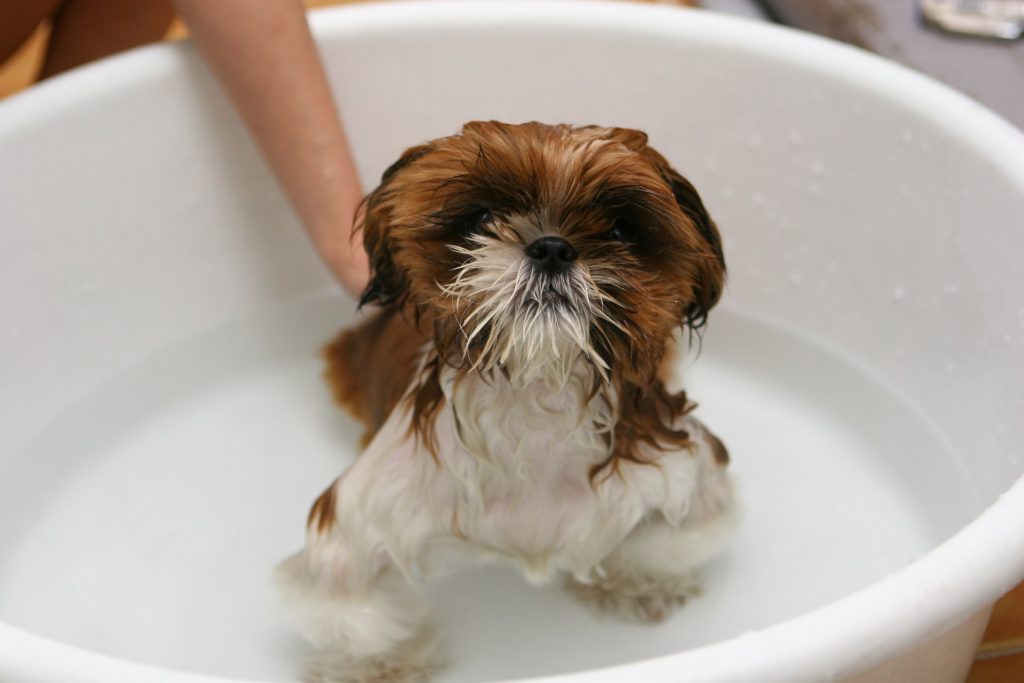
Okay, you know your dog needs a bath. Hopefully, you’ve laid the groundwork and made your chosen bath zone comforting. Time to get the supplies you’ll need to bathe your dog.
- Your dog’s brush
- A stack of towels
- Cotton balls
- Dog-safe shampoo (NO human shampoos!)
- A washcloth
- Treats
Remember those signs on the log flume ride proclaiming, “You will get wet on this ride?” The same logic applies here. Don’t wear clothes you’re attached to. Make sure you’re comfortable and able to move. (Even if your dog’s used to the bath process)
Prep Work
If you’re outside, make sure the weather’s nice. You don’t want your dog to get chilled. (This happens faster than you’d imagine) Also, make sure they stay in one location. The last thing you need is your freshly-bathed dog to make a beeline for the dirt. (Our dog knows exactly where the dry patch is)
If you use a sink or bathtub, consider putting steel wool on the drain. It’ll trap all of the loose dog hair and prevent a clog in the pipe. Place a towel on the bottom to provide a non-slip surface. (No doggie injuries, please) If you already have a non-slip mat, you’re good to go.
If you have a nervous dog, consider smearing peanut butter or canned dog food on the wall. It’ll distract them during the bathing.
Bathing Your Dog
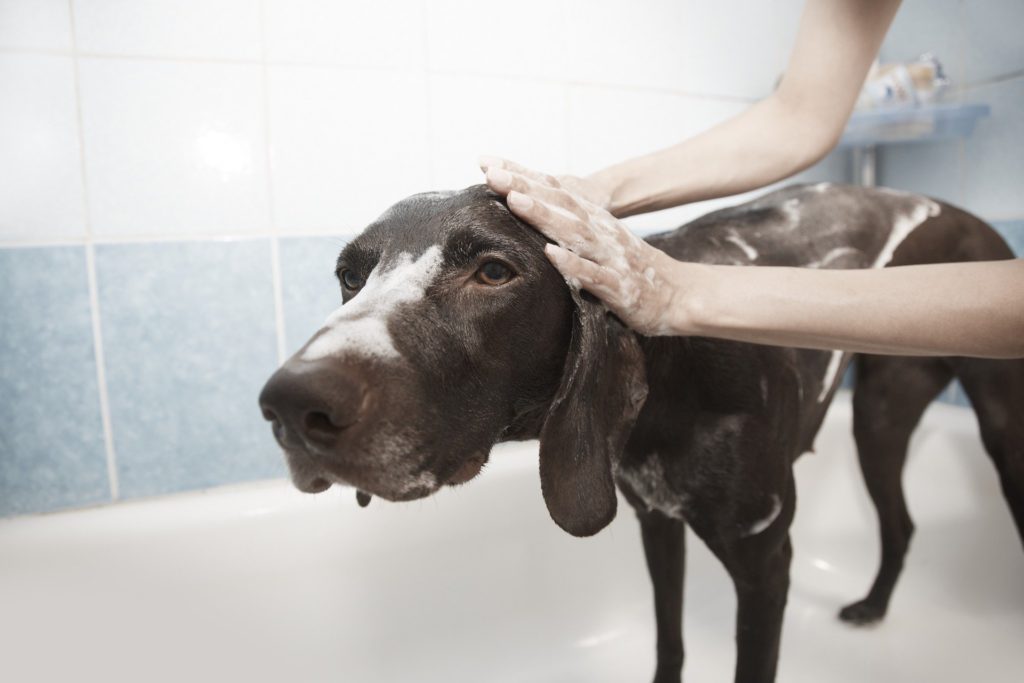
Okay: deep breath in, deep breath out. If you stay calm and positive, so will your dog.
- Brush your dog. If you don’t remove that extra hair, you’ll defeat the purpose of the bath and create mats.
- Place cotton balls inside your dog’s ears. You don’t want water to get inside, or they can develop ear infections. You can clean your dog’s ears separately with dog ear cleaners.
- Using LUKEWARM water (NO hot water!), rinse your dog from the NECK down. Talk the entire time softly. Angry voices make the bath a negative experience.
- Use the washcloth to clean their face.
- Massage the dog shampoo into their fur. You want to get in there: stomach, armpits, feet, tail, everything EXCEPT the face. Work from the neck down.
- Rinse with the same LUKEWARM water. Again, work from the neck down. You need to remove ALL of the shampoo. The residue will create a dry, itchy spot. If you feel any “slippery” places, that’s shampoo.
- Squeeze as much water from your dog’s coat as you can by hand.
- Hold a towel up as a barrier, and let your dog shake.
- Remove the cotton balls from their ears.
- Start to towel them dry. As a towel gets saturated, switch to a new one.
- Brush your dog every few minutes to help remove excess water.
- Give your dog a treat and lots of praise.
The Hair Dryer Debate
Some people advocate using a hairdryer. The problem is human hairdryers are too hot for use on your dog’s skin. You’ll end up burning them. If you opt for cool dryers, the force of the air is so weak, your dog will air-dry faster.
Dog grooming dryers use room temperature air. If you have one of these dryers, you can use it. You MUST monitor your dog at all times while it’s in use due to the high force of the dryer.
Groomers?
If you feel you can’t bathe your dog, groomers are always available. For some breeds, you’ll need a relationship with a groomer, even if you feel comfortable bathing your dog. Poodles, Malteses, and Yorkshire Terriers have hair that grows continuously throughout their lives (the same as ours). Without regular trims, that hair quickly gets out of control. So whether you let your groomer handle the haircut and bath or just the trim, find a groomer you trust.
Hit the Tub!
Once you get the hang of things, there’s no reason not to bathe your dog. You might even find yourself looking forward to bath times. If you make the bath a positive experience, even your dog will appreciate their fresh smell.
Okay, so they’d rather smell like the compost pile, but you’ll love the absence of that stinky dog scent!

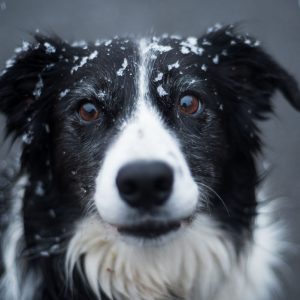

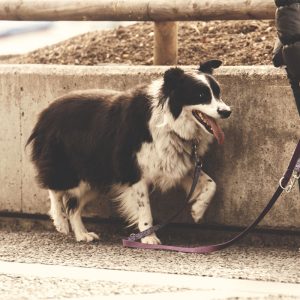


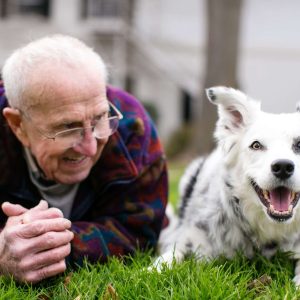

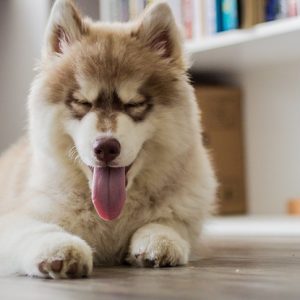
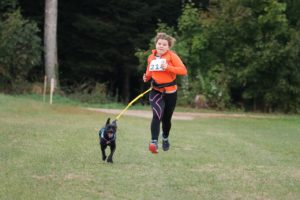


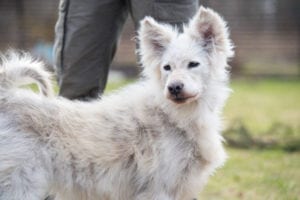
No comment yet, add your voice below!